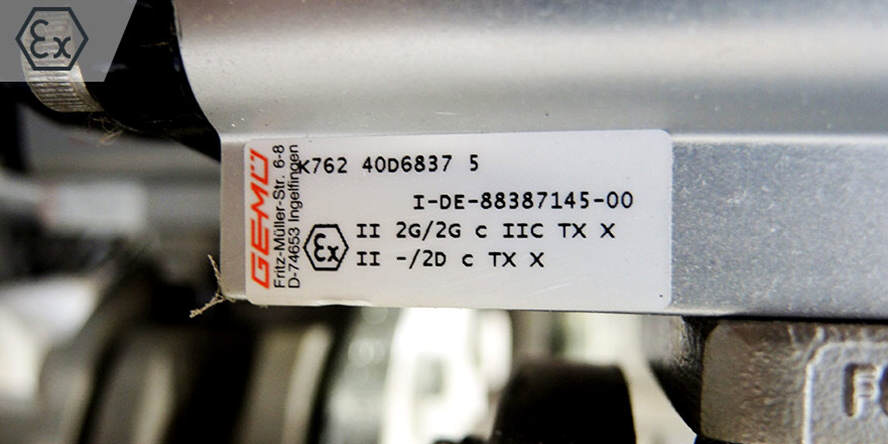
1. CE Mark
By putting the CE mark on a product, the manufacturer declares that the product meets the essential requirements of all the so called “New Approach” directives relating to the product. In order to determine whether a product meets the requirements of the “New Approach” directives and can be labelled with the CE mark, a conformity assessment is performed. The “New Approach” directives define the threats which the manufacturer must detect and eliminate before placing the product on the market. Issues covered by these directives:
- operational safety,
- health protection,
- environment protection.
2. Identification number of the Notified Body
A participation of a Notified Body is required at certain stages of the conformity assessment. The Notified Body is an entity which is independent from both the manufacturer and the consumer and has successfully passed the verification of competence and then obtained the authorisation of the competent minister. Each Notified Body is given an identification number.
3. Ex Designation
This is a special designation of protection applied for equipment and protective systems as well as for their parts and components.
4. Equipment Group
Equipment and protective systems are classified into one of the following groups in respect of the place of use:
| GROUP | DESCRIPTION |
| I | equipment and protective systems intended for use in mines where a risk of methane or coal dust explosion occurs |
| II | equipment and protective systems intended for use in places threatened with the occurrence of explosive atmospheres – other than those listed for Group I |
5. Equipment Category
Each of the equipment groups is divided into the categories shown in the following table:
| GROUP I | ||
| CATEGORY | ||
| M1 | Category M1 comprises equipment designed and, where necessary, equipped with additional special means of protection so as to be capable of functioning in conformity with the operational parameters established by the manufacturer and ensure a very high level of protection. Equipment in this category is designed so as to be capable of operating in an explosive atmosphere, even in the case of sporadic failures of the equipment, and be characterized by such security measures that:
|
|
| M2 | Category M2 comprises equipment designed so as to be capable of functioning in conformity with the operational parameters established by the manufacturer and ensure a high level of protection. This category equipment ensures:
|
|
| GROUP II | ||
| CATEGORY | Depending on whether the device is intended to work in dust or gaseous explosive atmospheres, a large enough letter D (for dust) or G (for gas) will be placed on its nameplate. And if the device can be operated in both atmospheres, it will be labelled with both symbols.
The marks described above occur together with the number 1, 2 or 3, (e.g. 2G or 3D) which informs the user about the security level applied for the equipment in respect of the possibility of occurrence of a source of ignition – the lower the value, the lower the probability that the equipment will become a source of ignition. |
|
| 1 | category 1 comprising equipment designed so as to be capable of functioning in conformity with the operational parameters established by the manufacturer and ensure a high level of protection. Equipment in this category:
|
|
| 2 | category 2 comprising equipment designed so as to be capable of functioning in conformity with the operational parameters established by the manufacturer and ensure a high level of protection. Equipment in this category:
|
|
| 3 | category 3 comprising equipment designed so as to be capable of functioning in conformity with the operational parameters established by the manufacturer and ensure a high level of protection. Equipment in this category:
|
|
6. Explosion Protection Type
| SELECTED EXPLOSION PROTECTION MARKS | ||
| MARK | DESCRIPTION | NORM |
| e | increased safety construction | PN-EN 60079-7 |
| t | protection of equipment against dust ignition by means of a casing | PN-EN 60079-31 |
| d | explosion-proof equipment in flame-proof shields | PN-EN 60079-1 |
| p | protection of equipment by means of overpressure gaseous envelopes | PN-EN 60079-2 |
| i | protection of equipment by means of intrinsically safe solutions | PN-EN 60079-11 |
| o | protection of equipment by means of an oil envelope | PN-EN 60079-6 |
| q | protection of equipment by means of a sand envelope | PN-EN 60079-5 |
| m | protection of equipment by means of encapsulation | PN-EN 60079-18 |
| n | protection of equipment by means of a type “n” casing | PN-EN 60079-15 |
| fr | protection of equipment by means of a chocked flow casing | PN-EN 13463-2 |
| c | protection of equipment by means of constructional safety | PN-EN 13463-5 |
| b | protection of equipment by means of ignition source control | PN-EN 13463-6 |
| k | protection of equipment by means of liquid immersion | PN-EN 13463-8 |
7. Explosiveness Group
Group II equipment with type “d”, “i”, “nC” and “nL” explosion-proof design intended for use in a gaseous explosive atmosphere can be divided in respect of the atmosphere nature. The breakdown is shown in the following table:
| EXPLOSIVENESS GROUP | DESCRIPTION |
| II A | propane group (e.g. acetone, methyl alcohol) |
| II B | ethylene group (e.g. ethylene, hydrogen sulphide, ethanol) |
| II C | hydrogen group (e.g. acetylene, hydrogen) |
The above classification is made on the basis of the Maximum Experimental Safe Gap (MESG) for flame-proof casings or the Minimum Ignition Current (MIC) of the substance for intrinsically safe electrical equipment.
8. Temperature Class and Maximum Surface Temperature
Group I equipment – the maximum surface temperature should not exceed:
- 150°C on any surface where a layer of coal dust can deposit,
- 450°C where deposition of a layer of dust is excluded (for example, due to sealing or ventilation) provided that the actual maximum temperature of the surface will be indicated in the equipment labelling.
Group II equipment should be marked with temperature class and/or the maximum surface temperature. In determining these parameters, the most adverse operating conditions for the device (but within the recognized tolerances) are taken into account.
| TEMPERATURE CLASS | MAXIMUM SURFACE TEMPERATURE [oC] |
| T1 | 450 |
| T2 | 300 |
| T3 | 200 |
| T4 | 135 |
| T5 | 100 |
| T6 | 85 |
When selecting equipment from the point of view of the flash point of the dust cloud and/or dust layer, the installation user should set the maximum permissible surface temperature Tmax for the equipment, taking into account the appropriate temperature margin (in accordance with PN-EN 60079-14). The most important information in this regard is set out in the table below.
| MAXIMUM PERMISSIBLE EQUIPMENT SURFACE TEMPERATURE FOR DUST | ||
| DUST CLOUD | DUST LAYER | |
| Tmax = 2/3TCLwhere TCL is the temperature of ignition of the expected dust cloud | the following methods are equivalent and ensure the same level of security. Selection of any of them depends on the method used for determining the equipment maximum surface temperature: | |
| dust-free method | dust layer method | |
| Tmax = T5mm – 75oC gdzie T5mm where T5mm is the temperature of ignition of a 5 mm layer of dust important: the increase in the thickness of the dust layer is accompanied by the decrease in the minimum flash point of the dust layer and increase in the thermal insulation. When the thickness of the dust layer exceeds 5 mm, appropriate correlation showing the relationship between the maximum permissible surface temperature and thickness of a layer of dust must be applied or a proper examination must be conducted. |
Tmax = T12,5mm – 25oC where T12,5mm is the temperature of ignition of a 12,5 mm layer of dust. important: the formula applies only to cases where the thickness of the dust layer does not exceed 12,5 mm |
|
In the case of gaseous atmospheres, the temperature margin should be determined by the manufacturer at the stage of assessing the product compatibility and included in the temperature class / maximum surface temperature of the equipment.
Depending on the type of explosion protection (see item 6), information on the temperature class / the maximum surface temperature may apply to the interior or exterior parts of the labelled equipment.
In cases where the maximum surface temperature depends mainly on special conditions (e.g., on the assembly method or temperature of the medium in the equipment) rather than on the equipment itself, the temperature class / the maximum surface temperature should be provided with an additional symbol “X”. The symbol tells the user that special conditions must be met for the safe use of the equipment.
The temperature class and maximum surface temperature are determined for the ambient temperature range of -20 to +40°C, otherwise the equipment designation should include information on this special situation. In practice, the nameplate includes the symbol Ta or Tamb with the respective range of ambient temperatures or the symbol “X”.





